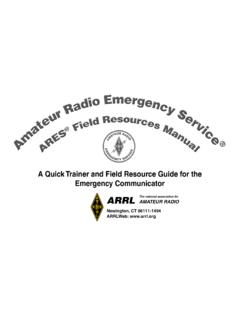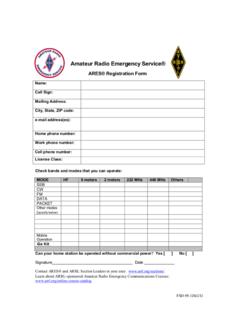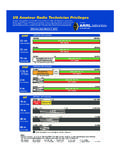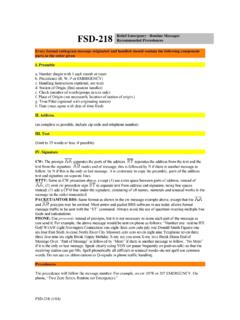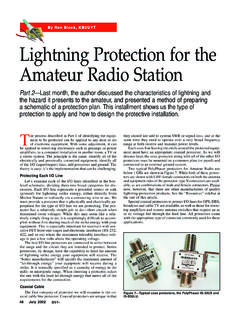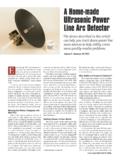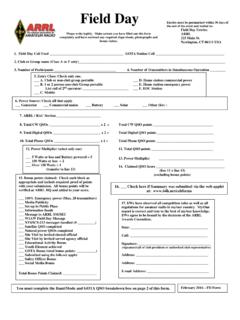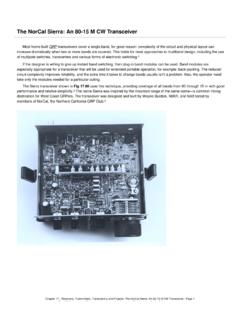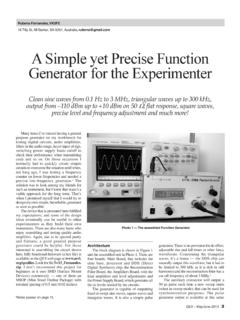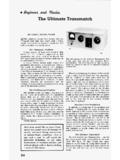Transcription of A Quick Trainer and Field Resource Guide for the Emergency ...
1 Page 1 The national association for amateur rAdioARRLN ewington, CT 06111-1494 ARRLWeb: Quick Trainer and Field Resource Guide for the Emergency CommunicatorCopyright 2005-2008 ISBN10: 0-87259-5439 ISBN13: 978-0-87259-5439 Page 2 This manual is intended to serve as a Quick Trainer and reference for amateurs deployed in the Field for Emergency services work, primarily through the ARRL amateur radio Emergency Service ( ares ). It provides basic program information, forms and operating aids. A number of templates can be customized for the local area to include reference information such as important phone numbers, Emergency frequencies, maps, organizational details and so forth. ARRL Membership and Volunteer Programs DepartmentNewington, ConnecticutJune 2008 ares and amateur radio Emergency Service are registered servicemarks of the American radio Relay League, 3 Table of ContentsTopic PageFirst Things First 5 Equipment and Personal Checklists 9 Basic Emergency Program Information 13 amateur radio Emergency Service 14 ( ares ) National Traffic System (NTS) 16 radio amateur Civil 19 Emergency Service (RACES) Incident Command System (ICS) 21 Information form for Media & Reporters 23 Hazardous Material Incident 26 DeploymentsBasic Operating Principles 29 Message Formats 33 Local Net/Contact Information 43 Section ares Map 52 Topic PageSection Emergency Plan 53 Operating Aids 57 Hurricane Information 65 Appendices 681) FCC Rules 692) Third Party Traffic Countries List 733) Common Power Connectors 764)
2 Mutual Assistance Team 78 (ARESMAT) Concept5) Understanding our MOUs 816) Wilderness Protocol 85 ares Registration Form 86 Incident Report Form 87 Incident Log Sheets 88 Page 4 NotesPage 5 Topic PageWhat to Do First in Case of an Emergency 6 Initial Action Checklist 7 First Things FirstPage 6 What to Do First in Case of an Emergency1) Check that you and your family are safe and secure before you respond as an ares volunteer. 2) Check that your property is safe and secure before you respond as an ares volunteer. 3) Monitor _____ (put your assigned local ares Emergency net frequency here).4) Follow the instructions you receive from the ares officials in charge on the above frequency. 5) Contact your local Emergency Coordinator, or his/her designee, for further 7 Initial Action ChecklistThe net control station and/or ares officials on the designated Emergency net will provide additional instructions, including information on frequencies used for other Resource and tactical nets.
3 Normally, a Resource net will enroll volunteers and provide information on how you can assist. Be prepared to operate. Check all equipment and connections. Check in with your assigned contact. Deploy to assignment with Ready kit. Obtain tactical call sign for your location/assignment. Initiate personal event log (use form at end of this booklet). Enter assigned frequency(s) on log sheet and on Emergency /frequency plan. Use log form to record messages handled. Use a formal message form when a precise record is required. Use tactical call sign for your location, and observe FCC s 10-minute ID rule. Monitor your assigned frequency at all times. Notify NCS if you have to 8 NotesPage 9 Topic PageBasic Deployment Equipment Checklist 10 Extended Deployment (72 Hour) Equipment Checklist 11 About Your Ready Kit 12 Equipment and Personal ChecklistsPage 10 Basic Deployment Equipment ChecklistWhen responding to an Emergency event, or even a training exercise, there is a minimum set of equipment and personal gear you should bring with you to get the job done.
4 Basic items include: 2-meter hand-held 2-meter mag-mount antenna and coax Earphone Paper and pencil ares ID card Extra batteries Appropriate clothing Food and waterThe majority of these items should be kept in a Ready Kit. Just pick it up on your way out the door for deployment. You might also consider the items on the following list for inclusion in this ready kit, designed to allow you to stay in the Field for up to 72 11 Extended Deployment (72 hour) Equipment Checklist 3 day change of clothes Foul weather gear Toilet articles Shelter (tent and sleeping bag) Portable stove; mess kit with cleaning kit Waterproof matches Flashlight Candles Alarm clock 3 day supply of water and food Liquid refreshments First aid kit Throat lozenges Prescriptions Aspirin or other pain reliever Additional radios, packet gear Power supplies, chargers Microphones Headphones Patch cords Antennas with mounts SWR bridge (VHF and HF) Extra coax RF connectors and adapters Power, audio and other connectors and adapters Batteries Toolbox Soldering iron and solder VOM Electrical and duct tape Safety glasses Log books Message formsPage 12 About Your Ready Kit Power Your 72-hour kit should have several sources of power in it, with extra battery packs and an alkaline battery pack for your handheld.
5 For mobile VHF and UHF radios, larger batteries are needed. Gel-cell or deep-cycle marine batteries are good sources of battery power, and you must keep them charged and ready go. It is also wise to have alternate means available to charge your batteries during the Emergency . You can charge smaller batteries from other larger batteries. You can build a solar charging device. If you re lucky, you may have access to a power generator that can be used in place of the normal electrical lines. Have more battery capacity than you think you might need. Have several methods available to connect your radios different power Antennas You can expect to need some kind of gain antenna for your handheld, as well as an additional gain antenna that can be used on either your handheld or your mobile rig. The extra antenna might be needed by someone else, or your first antenna might break.
6 For VHF and UHF, you can build a J-pole from TV twinlead for an inexpensive and very compact antenna. Have several lengths of coax in your kit, totaling at least 50 feet, and barrel connectors to connect them Include staples: water, or a reliable water filtration and purification system; enough food for three days; eating utensils, a drinking cup and, if needed, a means of cooking your food. Shelter is also important. Here, you are only limited by the size of your kit and the thickness of your wallet. Some hams plan to use their RVs as shelter, conditions permitting. Other disaster conditions may make the use of an RV impossible, so you should have several different plans for shelter. Light is important psychologically during an Emergency . Make sure that you have several light sources available. Various battery-powered lights are available, and lanterns that use propane or other fuel are also good 13 Topic PageAmateur radio Emergency Service ( ares ) 14 National Traffic System (NTS) 16 Types of Emergency Nets 18 radio amateur Civil Emergency Service (RACES) 19 Incident Command System (ICS) 21 National Incident Management System (NIMS) 22 When the News Media 22 ARRL amateur radio Emergency Communications Courses 23 Basic Emergency ProgramInformationPage 14 amateur radio Emergency Service ( ares )The ARRL amateur radio Emergency Service ( ares ) consists of licensed amateurs who have voluntarily registered their qualifications and equipment for communications duty in the public interest when disaster strikes.
7 Membership in ARRL or any other local or national organization is not required to join ares or participate in ares activities. ARRL membership is, however, required for the leadership appointments described here. Because ares is an amateur radio service, only licensed amateurs are eligible for OrganizationThere are three levels of ares organization section, district and local. At the section level, the Section Emergency Coordinator (SEC) is appointed by the Section Manager (SM) and works under his supervision. (The SM is elected by the ARRL members in the section.) In most sections, the SM delegates to the SEC the administration of the section Emergency plan and the authority to appoint District Emergency Coordinators (DECs), Assistant District Emergency Coordinators and local Emergency Coordinators (ECs) to help him run the ares program in the section.
8 An Assistant Section Emergency Coordinator may be appointed by either the SM or of the ares organization and operation gets accomplished at the local level. The local level is where most emergencies occur and where ares leaders make direct contact with the ares member-volunteers and with officials of the agencies to be served. The local EC is therefore the key contact in ares . The EC is Page 15appointed by the SEC, usually on the recommendation of the DEC (if there is one). Depending on how the SEC has set up the section for administrative purposes, the EC may have jurisdiction over a small community or a large city, an entire county or even a group of counties. Whatever jurisdiction is assigned, the EC is in charge of all ares activities in his area, not just one interest group, one agency, one club or one large sections, the SEC has the option of grouping EC jurisdictions into districts and appointing a District EC to coordinate the activities of the local ECs.
9 In some cases, the districts may conform to the boundaries of governmental planning or Emergency operations districts, while in others they are simply based on repeater coverage or geographical groups are headed up by assistant Emergency coordinators (AECs). Assistant ECs are designated by the EC to supervise activities of groups operating in certain bands, especially those groups that play an important role at the local level, but they may be designated in any manner the EC deems appropriate. These assistants, with the EC as chairman, constitute the local ares planning committee and they meet together to discuss problems and plan projects to keep the ares group active and well are any number of different situations and circumstances that might confront an EC, and his ares unit should be organized in anticipation of them. There is no specific point at which organization ceases and operation commences.
10 Both phases must be concurrent because a living organization is a changing one, and the operations must change with the 16 National Traffic System (NTS)The National Traffic System (NTS) is designed to meet two principal objectives: 1) rapid movement of traffic from origin to destination, and 2) training amateur operators to handle written traffic and participate in directed nets. NTS operates daily and consists of four different net levels Area, Region, Section, and Local. The four levels operate in an orderly time sequence to make a definite flow pattern for traffic from origin to NetsLocal nets are those covering small areas such as a community, city, county or metropolitan area, not a complete ARRL section. They usually operate at VHF (typically 2-meter FM) at times and on days most convenient to their members. Some are designated as Emergency ( ares ) nets that do not specialize in traffic handling.
